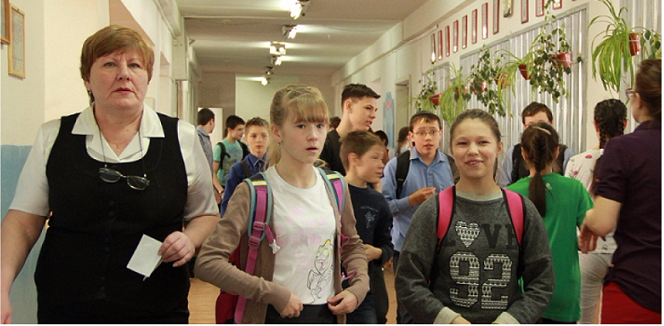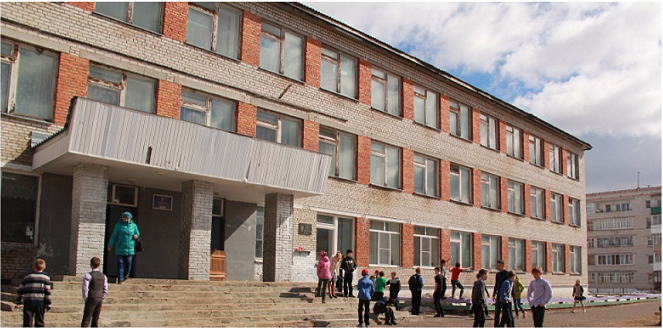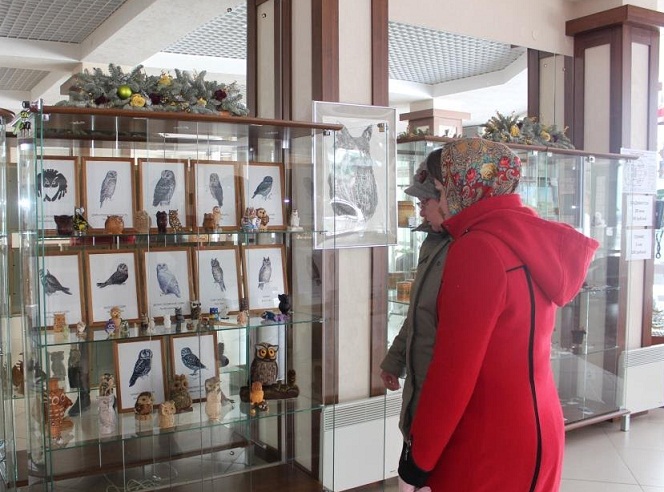Gaining Revenge
Young Udora intellectuals intend to challenge the Model River Mezen project experts with another intellectual game.
Young Udora intellectuals intend to challenge the Model River Mezen project experts with another intellectual game.
Silver Taiga’s lectures at Usogorsk secondary school spoke about the Mezen ichthyofauna.
As part of the Model River Mezen project implemented by the Silver Taiga Foundation for Sustainable Development, Nikolay Shilov, the project coordinator, conducted some classes devoted to the Mezen ichthyofauna diversity.
Lectures 35 minutes each seemed very short, as they were perceived at one sitting. Udora schoolchildren were truly interested in what Nikolay Shilov was telling them about the Mezen’s fish population during four classes for different groups. Meanwhile, it turned out that half of the participants in some groups were experienced fishers, and even some girls which may be surprising. Young fishermen enjoyed comparing their personal experience with the ichthyology expert’s lecture, they gesticulated a lot and tried to show the size of their biggest catch.
It is obvious that the ichthyofaunal of such a powerful river is rich and diverse. The kids got agitated when the story mentioned big inhabitants of the Mezen that are well known to them, such as salmon, grayling or burbot, but they were quiet when smaller fish often caught with a rod and paid so little attention to was discussed. At the lesson they saw the bigger size fish models, so they did not recognize the “old friend” at once. However, they appeared to know a lot about the bullhead recorded in the Red Book of the Russian Federation, which is the merit of local teachers of natural sciences. Silver Taiga’s expert immediately caught the attention of the audience and “hooked” them by starting the lesson with a question about the length of the Mezen river. The attendees found it difficult to answer, as they couldn’t say it right at once. Each of the kids is familiar with a particular section of the river only, and has never wondered how far the river they see as an element of the landscape extends beyond the horizon. The schoolchildren were surprised to learn that the length of the river they live by is almost a thousand kilometers.
The stone eel was given a special focus by Nikolay Shilov. Actually, it is not a fish, but it is remarkable by residing right in Udora rivers, so it became a so-called brand of the district. The children learnt how the Far East humpback salmon and famous Volga starlet had appeared to be in the Mezen. The humpback salmon was brought there on purpose in 1958 to accelerate the rate of return for fishery farms. As for the starlet, it is still a mystery how it managed to get in the Mezen.
The ichthyology expert continued his lecture about the humpback salmon and spoke about the scientists’ disputes related to whether this species habitation near salmon is harmful. According to his personal view, the humpback salmon has no effect on the salmon population, and it is just a myth that the Far East migrant ruins nests of the Atlantic salmon.
The “biography” of the burbot, the only representative of codfishes in the Mezen, was of great interest for the schoolchildren. Initially, it was a sea-fish, but owing to climate change it remained in freshwater habitat. When Nikolay Shilov spoke about the perch, he mentioned such topics as pollution and river shallowing. Perch likes plant-filled water bodies, and its population has been increasing too much recently, as river beds are not cleaned or deepened.
When the lessons were over, the schoolkids approached the lecturer with requests about a possibility to get to the summer ichthyology school facilitated by the Silver Taiga Foundation every year.


The Public Environmental Council at Udora District Administration is planning to address Head of the Komi Republic Sergey Gaplikov with a proposal to impose temporary restriction of access to the complex wildlife reserve.
Read more
That was the name of the environmental and regional study round table meeting arranged at the central library of Mezen at one of the weekends in March. Read more
Silver Taiga’s members have gathered a unique collection of souvenir owls made of various materials – wood, bark, bone, clay, glass, beads, wool, and even hay.
The Foundation’s employees brought figurines of this mysterious inhabitant of the Northern taiga from all over the world – from business trips and vacation tours. Silver Taiga’s friends also joined the tradition, and now you do not have to puzzle about what you want to present, when you visit the office again. Now, the Silver Taiga’s collection has around 70 bird figurines made with diverse techniques.

Visitors of the exhibition view the collection
The biggest part of the collection has recently “migrated” to the Finno-Ugric Ethnic Park to be exhibited there. The exhibition is dedicated to the International Bird Day globally celebrated on 1 April.
It was in 2003, when the collection was started. At that time, Olga Proskurina, a Foundation’s employee, brought an owl from Prague, where she had spent her vacation. “When I was walking along the narrow streets, I saw an owl-shaped cushion in the souvenir shop window. Ijustcouldn’tpassbyit. With its spread wings, it reminded of the Foundation’s logo”, Olga recalls. The owl she brought settled o the sofa in the Foundation’s office. Since then, owls have started migrating to Silver Taiga from different corners of the world which have been visited by the staff and partners of the environmental organization.
The logo of the Silver Taiga Foundation promoting sustainable development is the stylized depiction of an owl. The logo of Silver Taiga is a monochrome circular bird symbol represented in the traditional Komi manner known as the Permian animal style. The owl is the symbol of taiga, and it is also associated with wisdom. The image of an owl on the logo supports the Foundation’s slogan – Learning from Nature. The logo is simple and suitable to be used for various types of surface due to its universal character and elegance, absence of minor details and sharpness of the image, which makes it recognizable.
The exhibition in the Finno-Ugric Ethnic Park will last till 14 April 2017, then it will move from Yb to the Syktyvdin Center of Folk Crafts Zaran located in the village of Vylgort. The birds will return to their “nest” by 1 May.
Photos by N. Pautova
Last week, a two-day seminar Potential of Forest Resources and Management Data Obtaining Through Earth Remote Sensing trained volunteers of the youth public organization. The event was supported by the World Wildlife Fund and arranged in the NGO’s office in Arkhangelsk. Employees of the Onezhskoye Pomorye National Park also studied the GIS technology basics alongside with volunteers.
The Foundation’s experts – forestry coordinator Nikolay Shuktomov and GIS specialist Alexander Borovlyov – taught the attendees the principles of geographic information systems. They shared how to use the free geographic information system QGIS. With the help of case studies they showed the possibilities of modern cartographic web services, the SAS.Planet software, informed the participants about satellite imagery programs like Landsat and Sentinel, spoke about practical use of Earth remote sensing, data search and collection. Legal aspects of GIS and ERS application were given a special focus.
As became clear during the seminar, volunteers need GIS technologies to obtain objective data on the dynamics of forest cutting, forest fires, and reforestation activities. Young people do not intend to restrict themselves to secondary sources, where data are interpreted based on the author’s position. The representatives of the public organization were interested in the possibility to obtain the most recent data through Earth remote sensing and subsequent decoding of space images.
As for the national park staff, they are eager to grasp GIS technologies to perform their work in SPNA, in particular, to conduct winter route accounts which serve as the basis to determine hunting and fishing quotas. Therefore, the key focus was on how to develop skills to use simple GIS tools.
“GIS tools are getting more and more available for a wider audience, the technologies are entering our life, so more people are willing to grasp them. It is encouraging that those interested are not only professionals who have to use the tools at work, but also students many of which study liberal sciences”, said Silver Taiga’s forestry coordinator Nikolay Shuktomov.
On 23 March, 2017, the village of Yortom hosted the Developing Rural Tourism – Developing Rural Areas workshop for rural tourism facilitators and owners of guesthouses.
Participants of the “round table” meeting held by the Silver Taiga Foundation in Mezen, Arkhangelsk region, the middle of March, supported the ichthyologists’ opinion.
Every year, the Foundation’s staff visits Arkhangelsk region to meet residents of near-Mezen districts to plan and fulfil joint activities aimed at preservation of the aquatic bio resources of the Mezen river and their sustainable management. Such meetings are held as part of the Foundation’s project Sustainable Management of Fishery resources in Cooperation with the Local Population: Model River Mezen. The Silver Taiga’s professionals also appreciate the feedback they get during such visits, in particular, obtaining the data on the condition of fishery resources in Mezen districts of Arkhangelsk region for them to be compared with the results of the monitoring conducted at spawning tributaries of the Mezen in Komi.
The most recent accounting of redds performed by the Foundation show disappointing statistics – the population of salmon in the Mezen remains critically low. Last year, in total 200 km of the Mezen and its spawning tributaries were inspected; the expedition revealed just 160 redds (nests with eggs). For reference: in some Karelia’s rivers, as similar studies show, up to 200 redds account for each 120 meters.
“At the meetings with the residents in previous years, they mentioned all causes possible for such a dramatic fall of the salmon population, except for exploitation. They said fish was disappearing as a result of space junk falling from the sky, increased population of seals that eat salmon, river bed pollution, clear cutting, or other reasons. None of them were mentioned at the last meeting. The round table participants underlined, in particular, that amateur fishing of salmon at fishery plots was actually “a legal form of poaching”, says Nikolay Shilov, the Model River Mezen coordinator.
It is well known that in contrast to the Komi republic, where Mezen salmon catch is forbidden, Mezen and Leshukonye districts of Arkhangelsk region allow salmon fishing at fishery plots for recreation and sport. However, due to insufficient control, catching at fishery plots is exceeded many-fold.
One of the objectives of the Model River Mezen project is to change the near-Mezen residents’ focus to alternative activities, for instance, tourism. By the way, Mezen district can already boast of some successful stories of this business development.
The round table meeting was attended by representatives of the Public Fishery Council of Mezen district, local branch of the Russian Geographical Society, municipal and local authorities, SevRybVod, deputies of the district council and local fishers.
“The purpose of field trips to Arkhangelsk region is that residents of settlements in all the three adjacent districts in the Mezen basin – Udora in the Komi Republic, Mezen and Leshukonye districts in Arkhangelsk region – will unite in an effort to act jointly taking appropriate measures to protect the aquatic bio resources. The findings after the last trip to Mezen district show that the locals gradually start understanding the negative impact of amateur fishing and overexploitation exercised in the second half of the last century causing reduction of fish stock”, Nikolay Shilov sums up.
Photos by N. Shilov and S. Davydov
As the Silver Taiga Foundation promoting sustainable development believes, grasp of GIS technologies is necessary for rural residents eager to preserve forest areas that are most valuable for traditional use to be able to build meaningful communication with logging companies. In the middle of March the Foundation conducted a two-day “round table” workshop on GIS technology.
The workshop Potential of Forest Resources and Management Data Obtaining Through Earth Remote Sensing was arranged as part of the project Development of Competence and Community Involvement to Environmental Protection and Natural Resource Management at the North-West of Russia and Barents Region. Representatives of local communities (public forest councils, the Komi Voytyr interregional public movement), sole proprietors from Kortkeros, Priluzye, Syktyvdin, Udora and Ust-Kulom districts of the Komi Republic, and students of the Natural Science Institute, Syktyvkar State University, 20 people in total, took part in the “round table” training session.
“Unfortunately, local communities lack the needed skills and knowledge to handle cartographic data. They do not know the information that is openly available in the Internet and have no possibility to share the accumulated data with other participants of forest relations. The Komi Republic knows cases of disputes between the local population and logging companies because rural residents could not delineate traditional use forest areas which were considered necessary to be preserved from cutting. Villagers got used to allocate whole compartments of the forest areas interesting for them, while it was enough to take only minor areas used for hunting, mushroom or berry collection under protection. At the same time, logging companies find it unacceptable to exclude such huge areas from the intensive forest management territory. Grasp of GIS technology and use of cartographic web services will allow business and local communities to develop a dialogue based on detailed information and find optimal solutions for both parties,” says Nikolay Shuktomov, Silver Taiga’s forestry coordinator.
During the workshop, he and the Foundation’s GIS specialist Alexander Borovlyov informed the participants about basic cartographic concepts and definitions, open Internet sources, and the principles of the Earth remote sensing (ERS) data decoding. The practical tasks taught the workshop participants to create maps with the SAS.Planet software, exchange cartographic data, use navigators, apply GIS technologies to allocate traditional forest use areas. Though the time was limited, the Foundation’s members managed to work individually with each trainee.
“It is important that adequate use of GIS technologies allows more than just getting large amounts of information about different forest areas, it also makes it possible to simulate and plan further activities related to forest resource use,” Nikolay Shuktomov believes.
The trainees of the program noted that the information provided by the Foundation was made as comprehensible and easy to understand as possible. The feedback shows that GIS skills are highly demanded in remote rural areas, and not only in the Komi Republic. Therefore, a similar training workshop is planned to be held in the adjacent Arkhangelsk region in the near future.
Now, the Foundation has already compiled a cartographic data base including traditional forest use areas in some forested districts of the Komi Republic. The data are accessible for all activists interested, and harvesting companies. In the long-term perspective, the cartographic web service with traditional forest use areas is planned to be shared online at the Silver Taiga Foundation’s official website.
